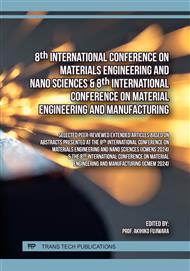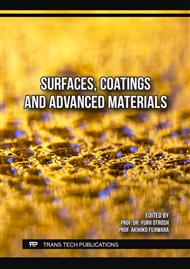[1]
S. Iijima, T. Ichihashi, Single-shell carbon nanotubes of 1-nm diameter, Nature. 363 (1993) 603–605.
DOI: 10.1038/363603a0
Google Scholar
[2]
T.W. Ebbesen, Carbon Nanotubes, Annual Reviews Material Sciences. 24 (1994) 235–264.
Google Scholar
[3]
N. Tokumitsu, Y. Shimamura, T. Fujii, Y. Inoue, Effect of Annealing and Diameter on Tensile Property of Spinnable Carbon Nanotube and Unidirectional Carbon Nanotube Reinforced Epoxy Composite, J. Compos. Sci. 6 (2022) 389.
DOI: 10.3390/jcs6120389
Google Scholar
[4]
T.H. Nam, K. Goto, Y. Shimamura, Y. Inoue, S. Ogihara, Property improvement of CNT spun yarns and their composites through pressing, stretching and tensioning, Advanced Composite Materials. 28 (2019) 507–524.
DOI: 10.1080/09243046.2019.1610586
Google Scholar
[5]
K.I. Tserpes, P. Papanikos, The effect of Stone–Wales defect on the tensile behavior and fracture of single-walled carbon nanotubes, Composite Structures. 79 (2007) 581–589.
DOI: 10.1016/j.compstruct.2006.02.020
Google Scholar
[6]
G. Yamamoto, K. Shirasu, T. Hashida, T. Takagi, J.W. Suk, J. An, R.D. Piner, R.S. Ruoff, Nanotube fracture during the failure of carbon nanotube/alumina composites, Carbon. 49 (2011) 3709–3716.
DOI: 10.1016/j.carbon.2011.04.022
Google Scholar
[7]
E.M. Byrne, M.A. McCarthy, Z. Xia, W.A. Curtin, Multiwall Nanotubes Can Be Stronger than Single Wall Nanotubes and Implications for Nanocomposite Design, Phys. Rev. Lett. 103 (2009) 045502.
DOI: 10.1103/PhysRevLett.103.045502
Google Scholar
[8]
K. Shirasu, G. Yamamoto, T. Hashida, How do the mechanical properties of carbon nanotubes increase? An experimental evaluation and modeling of the engineering tensile strength of individual carbon nanotubes, Mater. Res. Express. 6 (2019) 055047.
DOI: 10.1088/2053-1591/ab069f
Google Scholar
[9]
Y. Xiang, K. Shimoyama, K. Shirasu, G. Yamamoto, Machine Learning-Assisted High-Throughput Molecular Dynamics Simulation of High-Mechanical Performance Carbon Nanotube Structure, Nanomaterials. 10 (2020) 2459.
DOI: 10.3390/nano10122459
Google Scholar
[10]
Y. Xiang, G. Yamamoto, A Data Mining Approach to Investigate the Carbon Nanotubes Mechanical Properties via High-Throughput Molecular Simulation, MSF. 1023 (2021) 29–36.
DOI: 10.4028/www.scientific.net/MSF.1023.29
Google Scholar
[11]
D.W. Brenner, O.A. Shenderova, J.A. Harrison, S.J. Stuart, B. Ni, S.B. Sinnott, A second-generation reactive empirical bond order (REBO) potential energy expression for hydrocarbons, J. Phys.: Condens. Matter. 14 (2002) 783–802.
DOI: 10.1088/0953-8984/14/4/312
Google Scholar
[12]
G. Yamamoto, K. Shirasu, Y. Nozaka, Y. Sato, T. Takagi, T. Hashida, Structure–property relationships in thermally-annealed multi-walled carbon nanotubes, Carbon. 66 (2014) 219–226.
DOI: 10.1016/j.carbon.2013.08.061
Google Scholar
[13]
A.F. Ávila, G.S.R. Lacerda, Molecular mechanics applied to single-walled carbon nanotubes, Mat. Res. 11 (2008) 325–333.
DOI: 10.1590/S1516-14392008000300016
Google Scholar
[14]
Z.H. Xia, P.R. Guduru, W.A. Curtin, Enhancing Mechanical Properties of Multiwall Carbon Nanotubes via s p.3 Interwall Bridging, Phys. Rev. Lett. 98 (2007) 245501.
DOI: 10.1103/PhysRevLett.98.245501
Google Scholar
[15]
B. Peng, M. Locascio, P. Zapol, S. Li, S.L. Mielke, G.C. Schatz, H.D. Espinosa, Measurements of near-ultimate strength for multiwalled carbon nanotubes and irradiation-induced crosslinking improvements, Nature Nanotech. 3 (2008) 626–631.
DOI: 10.1038/nnano.2008.211
Google Scholar
[16]
E.T. Thostenson, T.-W. Chou, On the elastic properties of carbon nanotube-based composites: modelling and characterization, J. Phys. D: Appl. Phys. 36 (2003) 573–582.
DOI: 10.1088/0022-3727/36/5/323
Google Scholar
[17]
T.H. Nam, K. Goto, Y. Yamaguchi, E.V.A. Premalal, Y. Shimamura, Y. Inoue, K. Naito, S. Ogihara, Effects of CNT diameter on mechanical properties of aligned CNT sheets and composites, Composites Part A: Applied Science and Manufacturing. 76 (2015) 289–298.
DOI: 10.1016/j.compositesa.2015.06.009
Google Scholar
[18]
Y. Sun, Q. Chen, Diameter dependent strength of carbon nanotube reinforced composite, Applied Physics Letters. 95 (2009) 021901.
DOI: 10.1063/1.3168520
Google Scholar
[19]
C. Li, Elastic moduli of multi-walled carbon nanotubes and the effect of van der Waals forces, Composites Science and Technology. 63 (2003) 1517–1524.
DOI: 10.1016/S0266-3538(03)00072-1
Google Scholar
[20]
G. Yamamoto, Y. Chen, A. Kunitomo, N. Shigemitsu, T. Shindo, Decreasing vacancy-defect sensitivity in multi-walled carbon nanotubes through interwall coupling, Carbon Trends. 11 (2023) 100266.
DOI: 10.1016/j.cartre.2023.100266
Google Scholar



